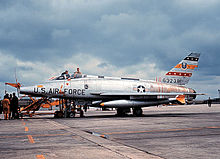
A nuclear weapon is an explosive device that derives its destructive force from nuclear reactions, either fission or a combination of fission and fusion reactions. Both bomb types release large quantities of energy from relatively small amounts of matter.

Nuclear technology is technology that involves the nuclear reactions of atomic nuclei. Among the notable nuclear technologies are nuclear reactors, nuclear medicine and nuclear weapons. It is also used, among other things, in smoke detectors and gun sights.

Nuclear weapons possess enormous destructive power from nuclear fission or combined fission and fusion reactions. Building on scientific breakthroughs made during the 1930s, the United States, the United Kingdom, Canada, and free France collaborated during World War II, in what was called the Manhattan Project, to build a fission weapon, also known as an atomic bomb. In August 1945, the atomic bombings of Hiroshima and Nagasaki were conducted by the United States against Japan at the close of that war, standing to date as the only use of nuclear weapons in hostilities. The Soviet Union started development shortly after with their own atomic bomb project, and not long after, both countries were developing even more powerful fusion weapons known as hydrogen bombs. Britain and France built their own systems in the 1950s, and the list of states with nuclear weapons has gradually grown larger in the decades since.

A nuclear and radiation accident is defined by the International Atomic Energy Agency (IAEA) as "an event that has led to significant consequences to people, the environment or the facility. Examples include lethal effects to individuals, large radioactivity release to the environment, reactor core melt." The prime example of a "major nuclear accident" is one in which a reactor core is damaged and significant amounts of radioactive isotopes are released, such as in the Chernobyl disaster in 1986 and Fukushima Daiichi nuclear disaster in 2011.
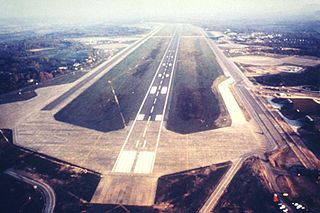
Royal Air Force Greenham Common or RAF Greenham Common is a former Royal Air Force station in the civil parishes of Greenham and Thatcham in the English county of Berkshire. The airfield was southeast of Newbury, about 55 miles (89 km) west of London.

Royal Air Force Lakenheath or RAF Lakenheath is a Royal Air Force station near the village of Lakenheath in Suffolk, England, UK, 4.7 miles (7.6 km) north-east of Mildenhall and 8.3 miles (13.4 km) west of Thetford. The base also sits close to Brandon.
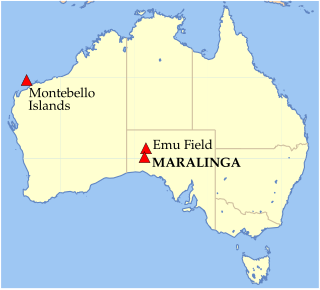
Between 1956 and 1963, the United Kingdom conducted seven nuclear tests at the Maralinga site in South Australia, part of the Woomera Prohibited Area about 800 kilometres (500 mi) north west of Adelaide. Two major test series were conducted: Operation Buffalo in 1956 and Operation Antler the following year. Approximate weapon yields ranged from 1 to 27 kilotons of TNT. The Maralinga site was also used for minor trials, tests of nuclear weapons components not involving nuclear explosions. Kittens were trials of neutron initiators; Rats and Tims measured how the fissile core of a nuclear weapon was compressed by the high explosive shock wave; and Vixens investigated the effects of fire or non-nuclear explosions on atomic weapons. The minor trials, numbering around 550, ultimately generated far more contamination than the major tests.
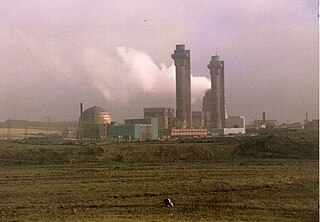
The Windscale fire of 10 October 1957 was the worst nuclear accident in the United Kingdom's history, and one of the worst in the world, ranked in severity at level 5 out of a possible 7 on the International Nuclear Event Scale. The fire took place in Unit 1 of the two-pile Windscale facility on the northwest coast of England in Cumberland. The two graphite-moderated reactors, referred to at the time as "piles," had been built as part of the British post-war atomic bomb project. Windscale Pile No. 1 was operational in October 1950, followed by Pile No. 2 in June 1951.
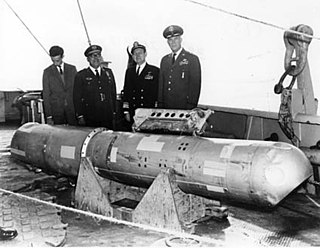
The 1966 Palomares B-52 crash, also called the Palomares incident, occurred on 17 January 1966, when a B-52G bomber of the United States Air Force's Strategic Air Command collided with a KC-135 tanker during mid-air refueling at 31,000 feet (9,450 m) over the Mediterranean Sea, off the coast of Spain. The KC-135 was destroyed when its fuel load ignited, killing all four crew members. The B-52G broke apart, killing three of the seven crew members aboard.

Sometime after midnight on 14 February 1950, a Convair B-36B, Air Force Serial Number 44-92075 assigned to the 7th Bombardment Wing, Heavy at Carswell Air Force Base, crashed in northwestern British Columbia on Mount Kologet after jettisoning a Mark 4 nuclear bomb. This was the first such nuclear weapon loss in history. The B-36B had been en route from Eielson Air Force Base near Fairbanks, Alaska to Carswell AFB in Fort Worth, Texas, more than 3,000 miles southeast, on a mission that included a simulated nuclear attack on San Francisco.

In 1952, the United Kingdom became the third country to develop and test nuclear weapons, and is one of the five nuclear-weapon states under the Treaty on the Non-Proliferation of Nuclear Weapons.

On 21 January 1968, an aircraft accident ; Danish: Thuleulykken) involving a United States Air Force (USAF) B-52 bomber occurred near Thule Air Base in the Danish territory of Greenland. The aircraft was carrying four B28FI thermonuclear bombs on a Cold War "Chrome Dome" alert mission over Baffin Bay when a cabin fire forced the crew to abandon the aircraft before they could carry out an emergency landing at Thule Air Base. Six crew members ejected safely, but one who did not have an ejection seat was killed while trying to bail out. The bomber crashed onto sea ice in North Star Bay, Greenland, causing the conventional explosives aboard to detonate and the nuclear payload to rupture and disperse, resulting in radioactive contamination of the area.

Between 1948 and 1992, personnel and aircraft of the United States Air Force (USAF) Strategic Air Command (SAC) were routinely deployed to bases in England. An informal agreement to base SAC bombers in the UK was reached between US General Carl Spaatz, and Marshal of the Royal Air Force (RAF) Lord Tedder, in July 1946. At that time there were only three bases in the UK deemed suitable for operating Boeing B-29 Superfortresses: RAF Lakenheath, RAF Marham and RAF Sculthorpe. These were airbases that had been extended during World War II when there were plans to use B-29s against Germany. When the Berlin Blockade began in June 1948, two B-29 groups deployed to the UK, but neither was equipped with Silverplate bombers capable of carrying nuclear weapons. Nuclear-capable Boeing B-50 Superfortress bombers began deploying in 1949, and nuclear bombs followed in 1950.

Project E was a joint project between the United States and the United Kingdom during the Cold War to provide nuclear weapons to the Royal Air Force (RAF) until sufficient British nuclear weapons became available. It was subsequently expanded to provide similar arrangements for the British Army of the Rhine. A maritime version of Project E known as Project N provided nuclear depth bombs used by the RAF Coastal Command.
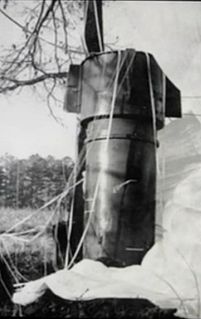
The 1961 Goldsboro B-52 crash was an accident that occurred near Goldsboro, North Carolina, on 23 January 1961. A Boeing B-52 Stratofortress carrying two 3–4-megaton Mark 39 nuclear bombs broke up in mid-air, dropping its nuclear payload in the process. The pilot in command, Walter Scott Tulloch, ordered the crew to eject at 9,000 feet (2,700 m). Five crewmen successfully ejected or bailed out of the aircraft and landed safely; another ejected, but did not survive the landing, and two died in the crash. Information declassified in 2013 showed that one of the bombs came very close to detonating.

Nuclear ethics is a cross-disciplinary field of academic and policy-relevant study in which the problems associated with nuclear warfare, nuclear deterrence, nuclear arms control, nuclear disarmament, or nuclear energy are examined through one or more ethical or moral theories or frameworks. In contemporary security studies, the problems of nuclear warfare, deterrence, proliferation, and so forth are often understood strictly in political, strategic, or military terms. In the study of international organizations and law, however, these problems are also understood in legal terms. Nuclear ethics assumes that the very real possibilities of human extinction, mass human destruction, or mass environmental damage which could result from nuclear warfare are deep ethical or moral problems. Specifically, it assumes that the outcomes of human extinction, mass human destruction, or environmental damage count as moral evils. Another area of inquiry concerns future generations and the burden that nuclear waste and pollution imposes on them. Some scholars have concluded that it is therefore morally wrong to act in ways that produce these outcomes, which means it is morally wrong to engage in nuclear warfare.

Command and Control: Nuclear Weapons, the Damascus Accident, and the Illusion of Safety is a 2013 nonfiction book by Eric Schlosser about the history of nuclear weapons systems and accidents involving nuclear weapons in the United States. Incidents Schlosser discusses in the book include the 1980 Damascus Titan missile explosion, the 1966 Palomares B-52 crash, and the 1961 Goldsboro B-52 crash. It was a finalist for the 2014 Pulitzer Prize for History. A documentary film based on the book aired as an episode of American Experience on PBS in early 2017.

